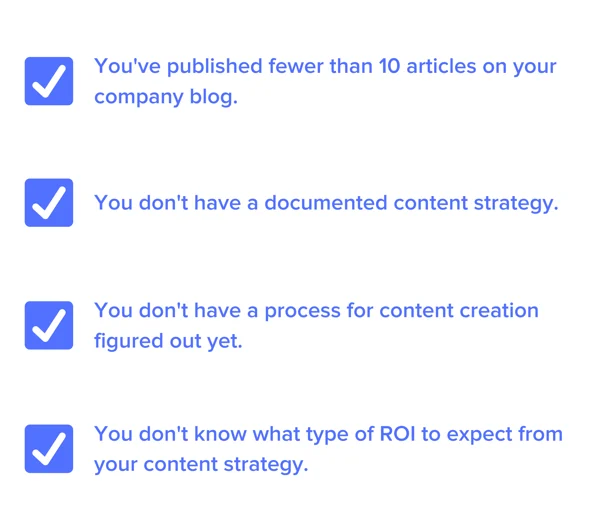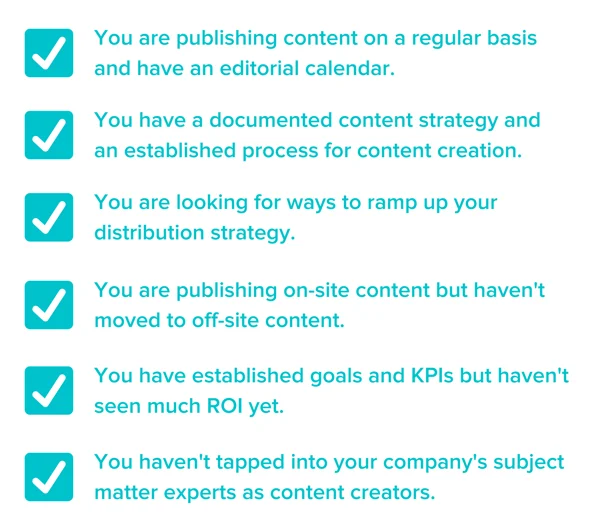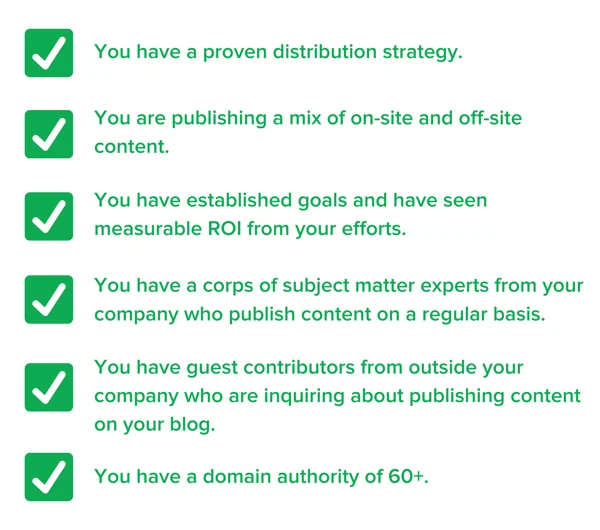
The Types of Content You Should Be Publishing at Each Stage of Your Content Marketing Journey
The Types of Content You Should Be Publishing at Each Stage of Your Content Marketing Journey
Kelsey Raymond, COO • Intero Digital • April 24, 2019

If you ever see old pictures of yourself and think, “Who the heck let me out of the house wearing that?” you’re definitely not alone. As we mature, we find out what works best for us in a lot of different areas. That holds true for clothing styles, totally tubular slang, and even content marketing.
Like a fine wine, content marketing can keep getting better with age if you nurture it the right way. But to help it mature, you have to know what stage it’s at right now. We’ve identified the three stages of content marketing maturity to help you see how you can keep growing your content marketing strategy.
What an Early Content Strategy Looks Like
Signals that you’re in this stage:

In the beginning stages, you probably don’t yet have a documented content strategy. While a content strategy is a living, breathing document that can evolve over time, getting something on paper is an essential step for ensuring that the members of your content marketing team are on the same page about what you are trying to accomplish. It also holds you accountable and documents all of your ideas in one spot.
Here are some suggestions for what to include in your first documented content marketing strategy:
- An overview of your target audience
- Details about what voice and tone you’d like your content to have
- Key performance indicators that you’ll use to determine your success
- The process you’ll follow to create your content, who needs to be involved in the approval process, and your content distribution strategy
While you’re putting together your documented content strategy, you’ll also iron out crucial details that will help you scale in the long run, like your process for creating content and what success looks like for your content strategy.
In addition to a documented content strategy, you’ll also want to start establishing a cadence for publishing content and creating a process for ensuring your content is being pushed out via social media. You’ll also want to start doing the necessary research to ensure you’re creating content that your audience is looking for. While some of this is trial and error, performing keyword research and talking to your sales and customer service teams to understand what questions are coming up in their conversations will give you insight into the type of information that your audience wants to see and will help you shape your content strategy.
What Type of Content Should You Be Publishing at This Stage?
While it’s always important to focus on quality over quantity, this is even more critical when you’re first starting out. In the beginning, you should start with long-form content that will serve as the anchor for your strategy. Here are two examples of cornerstones to consider starting with:
A whitepaper: If you want to generate leads with your content, start by creating an in-depth and informative gated whitepaper. Try to think of a broad topic so you can easily promote your whitepaper within other pieces of content that you create.
You can always publish more whitepapers that cover a particular niche in your business, but starting broad will ensure you have a piece of content that you can keep promoting again and again.
A pillar page: A pillar blog post is an in-depth, long-form blog post that includes a lot of information about a single topic. Generally, such articles are between 1,500 and 3,000 words long and contain additional elements like graphics and even videos. A pillar page is vital for an SEO-focused content strategy because it serves as an anchor piece to build links to and signals to search engines that this is the very best article you have to offer on a specific topic that should be ranking in search results.
While a whitepaper is essential for lead generation and a pillar blog post is essential for SEO, both of these pieces of content can also serve additional purposes for your business:
- This long-form content can communicate your company’s thought leadership, helping you build trust and credibility with your audience.
- These pieces can enhance sales conversations with potential prospects who need more education on a topic.
- These pieces serve as great training materials for new hires who need to learn more about your industry.
What an Intermediate Content Strategy Looks Like
Signals that you are in this stage:

As your content strategy becomes more advanced, you’ll find that you’ve got the basics in place. You have a process for creating and distributing your content and have a documented strategy, but you are still looking for ways to take your efforts to the next level.
What Content Can Help Take Your Strategy to the Next Level?
Guest-contributed articles: Go beyond just blogging and start getting your content in front of readers at publications that fit your target audience. This offers several benefits. When key subject matter experts from within your company byline content on other sites, it communicates their thought leadership and builds their credibility. Guest posting helps you earn relevant backlinks to your site, and it engages a new audience to help create a flow of new traffic and potential leads back to your website.
Newsletters: Newsletters are a great way to keep your audience engaged and in the know about what you’re publishing. If you are already creating valuable content regularly, it’s in your best interest to put together either a weekly or monthly email newsletter with links to your most recent content. It never hurts to nudge your target audience in the right direction.
Paid amplification: Why spend all your time and energy creating content only to discover that people aren’t actually reading it? By investing in paid amplification via sponsored posts on social media platforms and Google Ads, you can get your content in front of a highly targeted audience, which will help you curate an engaged following on your website.
What an Advanced Content Strategy Looks Like
Signals that you’re in this stage:

At this stage, you’re a content marketing pro. You have an established process for content creation and have seen proven ROI from your efforts. From here, the sky is the limit. What used to be a simple blog on your website is now a full-fledged publication.
What Content Can Help Take Your Strategy to the Next Level?
Videos: Go beyond simply publishing written content and give your readers a new medium to interact with. As a bonus, this content is also perfect for sharing on social media.
Content from guest contributors: Because you now treat your blog as a full-fledged publication, you’ll need to ramp up the amount of content you’re publishing. One way to do that (and expand the types of topics you have the expertise to discuss) is by publishing content from experts outside of your company.
Let’s be clear: There’s no such thing as a wrong stage of content marketing. However, once you learn where you’re at and what can be accomplished by bumping up your efforts, it’s hard to imagine that maturing your content marketing strategy wouldn’t make it onto your to-do list.
Take it from us — we’ve been growing our own content marketing maturity from the ground up since our company started. And we’re here to say that it really works! Content marketing is not a sprint method with instant results; it’s a steady build-up that delivers a big impact. No matter where your strategy is in terms of maturity, there’s always room for growth. And it’s absolutely worth it.
